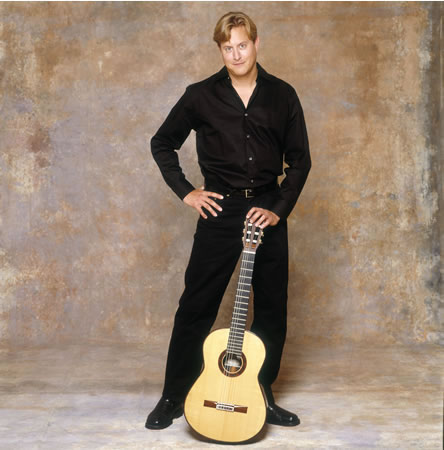French composers go to Spain–not for the first time–at Music@Menlo
The ebullient Wu Han, whose familial welcomes to Music@Menlo programs rival Jackie Kennedy’s ability to make people feel at home in the White House, was having a good laugh. Noting that the festival just finished presenting a program of Paris in the 1920s that included three Americans and one Russian composer, and an American program with music by Dvorak, she chuckled at a Spanish program that included Debussy and Ravel, two turn-of-the-century greats who fell under the Spanish spell.
The good feelings remained as guitarist Jason Vieaux took to the platform of Stent Family Hall’s ballroom. The acoustic of the extremely live 148-seat hall, whose ornate plaster walls are adorned with mirrors and other reflective surfaces, allowed for maximum impact of Vieaux’s instrument. Not that Vieaux had to worry. The guitar, made by Gernot Wagner (2005), owes its extra resonance to a unique double-wood top of spruce (for clarity and color) and cedar (for power, punch, and bass resonance), with a “sandwich” center of Nomex that has a honeycomb pattern of holes drilled throughout.
Thanks to his supreme command of color, Vieaux’s performances of three works by Albéniz were the highlight of the evening. The lilting transparency of Albeniz’ Mallorca brought to mind a brightly colored veil blowing in a gentle wind, and the facile fingerwork, tang, and shifts of dynamics and shading in Torre Bermeja were masterful. The beauty of Vieaux’s playing, which undulated with understated elegance, brought forth smiles and cheers from the audience.
If only the Jupiter String Quartet had been as technically secure. Unfortunately, in both Debussy’s String Quartet in G minor and Turina’s La oración del torero, first violinist Nelson Lee’s tone had a tendency to turn sour when playing fast and forte. It’s a shame, because the quartet’s soft high passages were gorgeous, and the close of the Debussy positively rapturous. But the supreme control and musicianship of the Miró Quartet, which distinguished earlier programs, were not in evidence.
The big miss of the evening was mezzo-soprano’s Sasha Cooke’s rendition of de Falla’s Siete canciones poulares españolas. Despite Vieaux’s skill as accompanist, Cooke did not seem to know how to summon up the right energy for these songs. Even at her most animated, a cool, placid core to the voice prevented the temperature from rising anywhere near boiling point. Yes, Cooke’s soft tones were wonderful, and her low range ingratiatingly warm and plush, but the accent, the feel, and the sound were wrong.
In the concluding work, Ravel’s Piano Trio, pianist Alessio Bax contributed haunting tone and supreme dynamic control. Cellist Laurence Lesser had his share of intonation problems, but violinist Arnaud Sussmann fully matched Bax’s exalted musicianship. With balances masterfully controlled, the evening climaxed with a finale that progressed from watery mystery to near-symphonic magnificence.
Jason Victor Serinus writes about music for Opera News, Opera Now, American Record Guide, Stereophile, San Francisco Classical Voice, San Francisco Magazine, Carnegie Hall Playbill, San Francisco Examiner, Bay Area Reporter, hometheaterhifi.com, Spirit of Change, and other publications. www.jasonserinus.com.
